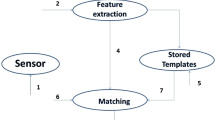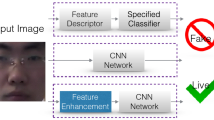Abstract
Today, face recognition is the most widely used biometric recognition technology. However, face recognition is a biometric method that is vulnerable to spoofing. Types of spoofing attack include print, replay, and 3D mask. Methods based on hand-crafted features such as local binary patterns which use high-frequency features of images, are therefore vulnerable to blur caused by optical factors or motion. Recently, face spoofing detection methods based on learned features using the convolutional neural network series have been introduced. Among them, DenseNet-121 has a densely connected structure unlike the other structure, so it can widely reflect the characteristics of various frequency bands of an image. In this paper, we study face-spoofing detection using DenseNet-121. For the performance measurement, CASIA-FASD and a lab-made PR-FSAD were used. As a result of the experiment, it was confirmed that DenseNet showed good face spoofing detection performance in both DBs. This result can be analyzed because of the structural characteristics that DenseNet-121 well reflects the wide frequency characteristics of the image.
Access this chapter
Tax calculation will be finalised at checkout
Purchases are for personal use only
Similar content being viewed by others
References
Biggio, B., Akhtar, Z., Fumera, G., Marcialis, G.L., Roli, F.: Security evaluation of biometric authentication systems under real spoofing attacks. IET Biometrics 1(1), 11–24 (2012)
Tian, Y., Xiang, S.: Detection of video-based face spoofing using LBP and multiscale DCT. In: Shi, Y.Q., Kim, H.J., Perez-Gonzalez, F., Liu, F. (eds.) IWDW 2016. LNCS, vol. 10082, pp. 16–28. Springer, Cham (2017). https://doi.org/10.1007/978-3-319-53465-7_2
Benlamoudi, A., Samai, D., Ouafi, A., Taleb-Ahmed, A., Bekhouche, S.E., Hadid, A.: Face spoofing detection from single images using active shape models with stasm and lbp. In: Proceeding of the Troisime Conference Internationale sur la vision artificielle CVA, vol. 2015, p. 31 (2015)
Määttä, J., Hadid, A., Pietikäinen, M.: Face spoofing detection from single images using micro-texture analysis. In: 2011 International Joint Conference on Biometrics (IJCB), pp. 1–7. IEEE (2011).
Li, L., Feng, X., Boulkenafet, Z., Xia, Z., Li, M., Hadid, A.: An original face anti-spoofing approach using partial convolutional neural network. In: 2016 Sixth International Conference on Image Processing Theory, Tools and Applications (IPTA), pp. 1–6. IEEE (2016)
Xu, Z., Li, S., Deng, W.: Learning temporal features using LSTM-CNN architecture for face anti-spoofing. In: 2015 3rd IAPR Asian Conference on Pattern Recognition (ACPR), pp. 141–145 IEEE (2015)
LeCun, Y., Bengio, Y., Hinton, G.: Deep learning. Nature 521(7553), 436–444 (2015)
Huang, G., Liu, Z., Van Der Maaten, L., Weinberger, K.Q.: Densely connected convolutional networks. In: Proceedings of the IEEE Conference on Computer Vision and Pattern Recognition, pp. 4700–4708 (2017)
Zhang, Z., Yan, J., Liu, S., Lei, Z., Yi, D., Li, S.Z.: A face antispoofing database with diverse attacks. In: 2012 5th IAPR International Conference on Biometrics (ICB), IEEE, pp. 26–31 (2012)
Bok, J.Y., Suh, K.H., Lee, E.C.: Verifying the effectiveness of new face spoofing DB with capture angle and distance. Electronics 9(4), 661 (2020)
He, K., Zhang, X., Ren, S., Sun, J.: Deep residual learning for image recognition. In: Proceedings of the IEEE Conference on Computer Vision and Pattern Recognition, pp. 770–778 (2016)
Acknowledgement
This research was supported by the Bio & Medical Technology Development Program of the NRF funded by the Korean government, MSIT(NRF-2016M3A9E1915855). Also, this work was financially supported by a Grant (2018000210004) from the Ministry of Environment, Republic of Korea.
Author information
Authors and Affiliations
Corresponding author
Editor information
Editors and Affiliations
Rights and permissions
Copyright information
© 2021 Springer Nature Switzerland AG
About this paper
Cite this paper
Yu, SG., kim, SE., Suh, K.H., Lee, E.C. (2021). Face Spoofing Detection Using DenseNet. In: Singh, M., Kang, DK., Lee, JH., Tiwary, U.S., Singh, D., Chung, WY. (eds) Intelligent Human Computer Interaction. IHCI 2020. Lecture Notes in Computer Science(), vol 12616. Springer, Cham. https://doi.org/10.1007/978-3-030-68452-5_24
Download citation
DOI: https://doi.org/10.1007/978-3-030-68452-5_24
Published:
Publisher Name: Springer, Cham
Print ISBN: 978-3-030-68451-8
Online ISBN: 978-3-030-68452-5
eBook Packages: Computer ScienceComputer Science (R0)




